Are you on the hunt for the perfect flowering or foliage plants to jazz up your window box planters? Well, look no further than this list! Below, you’ll find an array of showstopping annuals that will brighten up your home in both sun and shade.
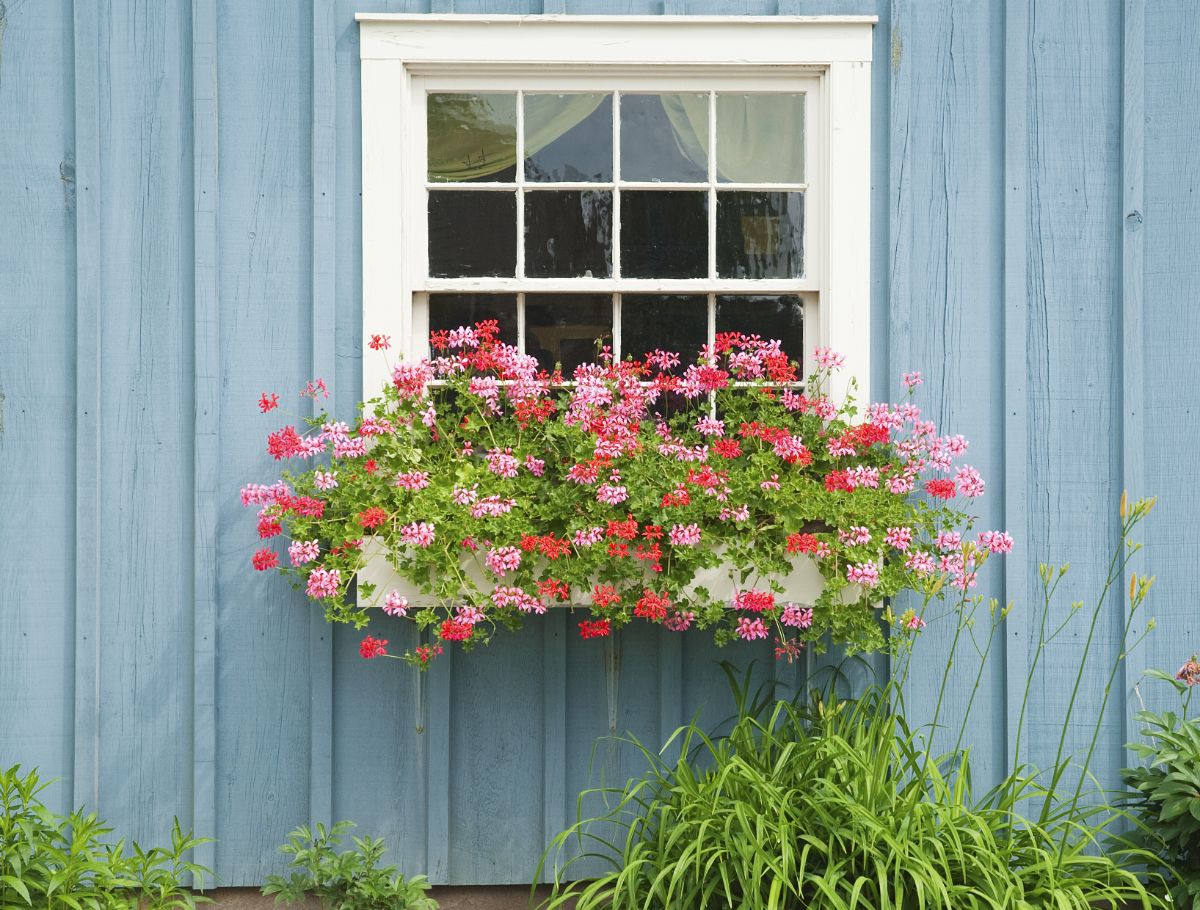
Jump to:
- 21 beginner-friendly annuals to grow in window boxes
- 1. Zinnias (Zinnia elegans)
- 2. Snapdragons (Antirrhinum majus)
- 3. Caladiums (Caladium bicolor)
- 4. Petunias (Petunia spp.)
- 5. Verbena (Verbena spp.)
- 6. Marigolds (Tagetes spp.)
- 7. Canna lilies (Canna spp.)
- 8. Herbs
- 9. Sweet alyssum (Lobularia maritima)
- 10. Impatiens (Impatiens spp.)
- 11. Zonal geraniums (Pelargonium zonale)
- 12. Begonias (Begonia spp.)
- 13. Cosmos (Cosmos bipinnatus)
- 14. Million bells (Calibrachoa spp.)
- 15. Heliotrope (Heliotropium arborescens)
- 16. Ranunculus (Ranunculus spp.)
- 17. Spider flowers (Cleome spp.)
- 18. Creeping Jenny (Lysimachia nummularia)
- 19. Mums (Chrysanthemum morifolium)
- 20. Lantana (Lantana camara)
- 21. Coleus (Solenostemon scutellarioides)
- Summary
21 beginner-friendly annuals to grow in window boxes

The best plants for window boxes tend to be flashy plants with short, upright growth habits and lots of fantastic colors. But for even more spice, you may want to throw a few trailing plants and vines into your window box planters to create a layered design that draws the eye in. If plants have lots of texture and move with the wind or if they attract pollinators like butterflies, that’s even better!
1. Zinnias (Zinnia elegans)
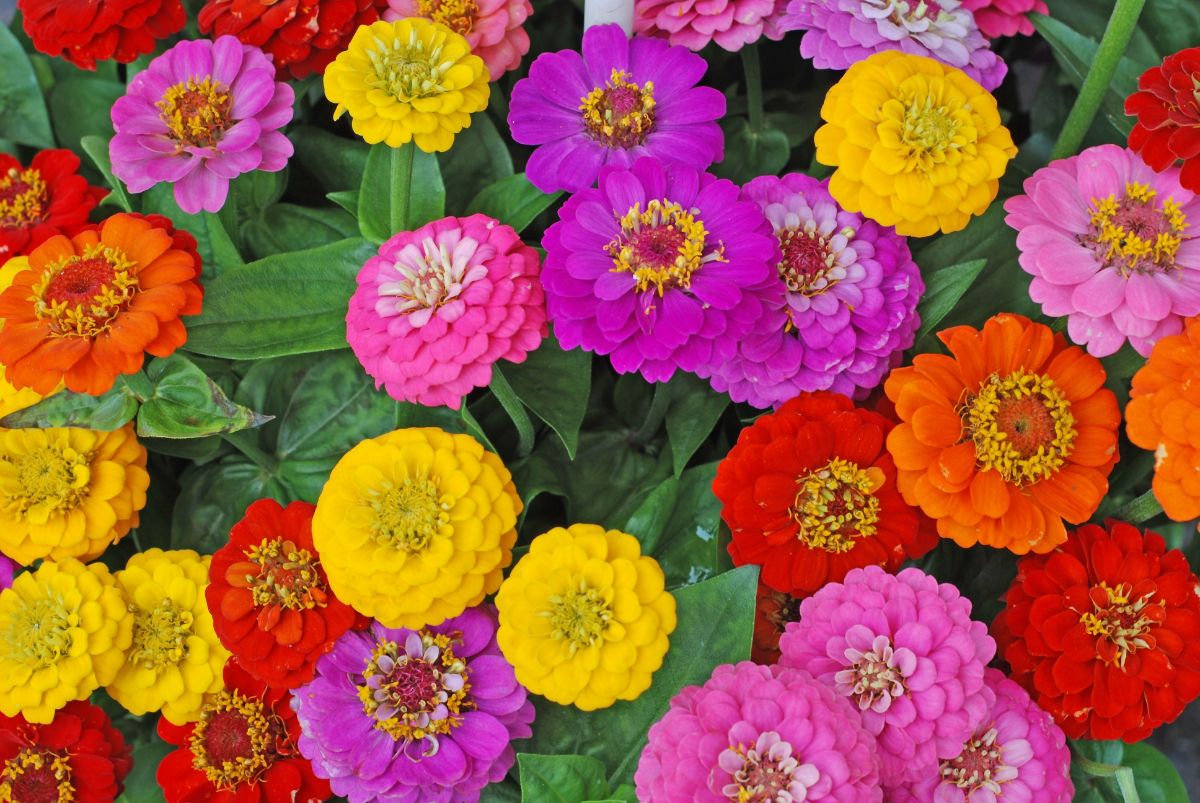
| Plant name: | Zinnias |
| Light requirements: | Full sun; can tolerate part shade in hot areas |
| Water requirements | Moderate |
| Special features: | Good for cut flowers; Easy to grow from seed |
A top-notch cutting flower, zinnias look pretty in indoor vases and bouquets, but they can lighten up window boxes, too. Often confused with dahlias, many zinnias are relatively small plants that grow to about 1’ tall, although you can find taller varieties that stretch up to 4’ in height. Zinnias are most famous for their colorful flowers, which come in both single and double-bloomed options, and those blooms sport petals in almost any color you could imagine!
If you’d like to get zinnia blooms quickly, you can grow plants from nursery starts. But zinnias also grow reliably from seed, and you can collect zinnia seeds at the end of the season for seed saving. Aside from their beauty, zinnias are also highly attractive to bees and other pollinators, but make sure that you select single-bloomed varieties for pollinators as these flowers are more enticing to insects.
2. Snapdragons (Antirrhinum majus)
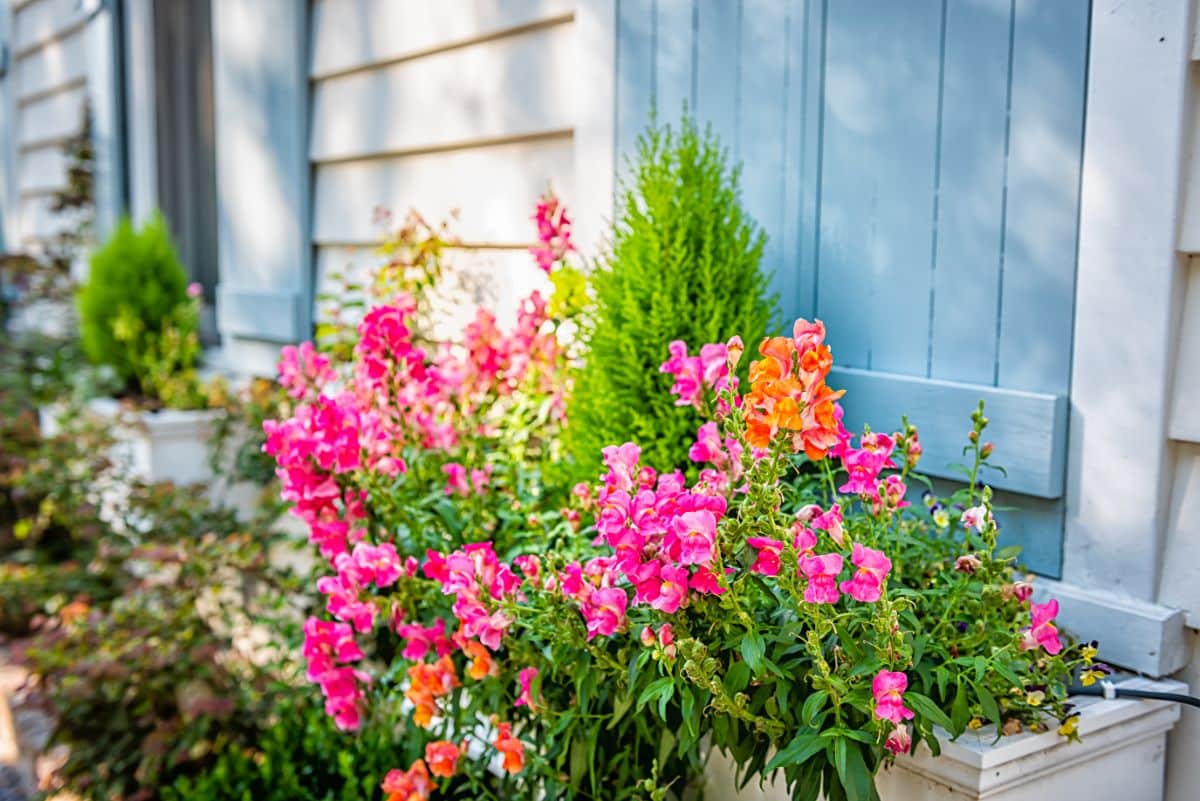
| Plant name: | Snapdragons |
| Light requirements: | Full sun to part shade |
| Water requirements | Moderate |
| Special features: | Easy to grow from seed |
A cottage garden favorite, snapdragons may look delicate, but they can grow in a range of conditions, and they’re also some of the most cold hardy plants you can find. Most varieties of snapdragons grow between 6 and 15” tall, so they won’t block out windows and other key features on your home. However, you can find taller varieties of snapdragons that stretch up to 48” tall if you want plants that make an even bigger impact!
Like zinnias, snapdragons come in a rainbow of colors, and you can select just a single flower color to accentuate the shades of your home or plant a mix of snapdragon hues. Like many other annuals, snapdragons are easy to grow from seed, but you can also buy flats of snapdragons in spring and get flowers even earlier!
3. Caladiums (Caladium bicolor)
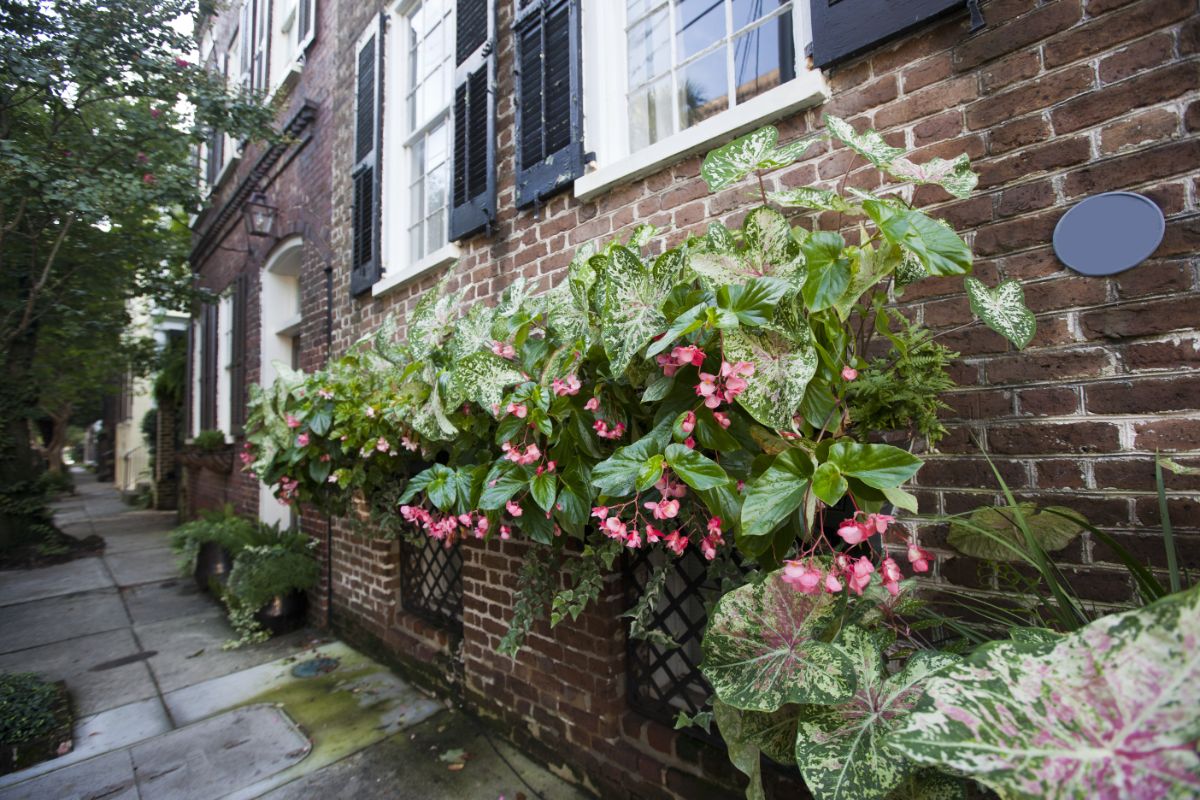
| Plant name: | Caladiums |
| Light requirements: | Part shade |
| Water requirements | Moderate |
| Special features: | Can double as houseplants |
When most growers think about designing window boxes for their homes, they envision brilliantly colored, flowering plants. But if you’d like to create a more complex and intriguing window box display, you may also want to throw some foliage plants into the mix. Ferns and succulents are common choices for window boxes, but if you dream of plants with vibrant leaves that draw the eye in, caladiums are hard to beat!
Caladium leaves are boldly colored with shades of green, pink, and red; however, some of the most bewitching caladiums you can find are those with pale white leaves that catch the sunlight like stained glass windows. Caladiums are not frost hardy and they will die away in winter. However, if you love your caladium plants and want to keep them going, you can overwinter plants indoors as houseplants… just keep in mind that caladium leaves are toxic to pets!
4. Petunias (Petunia spp.)
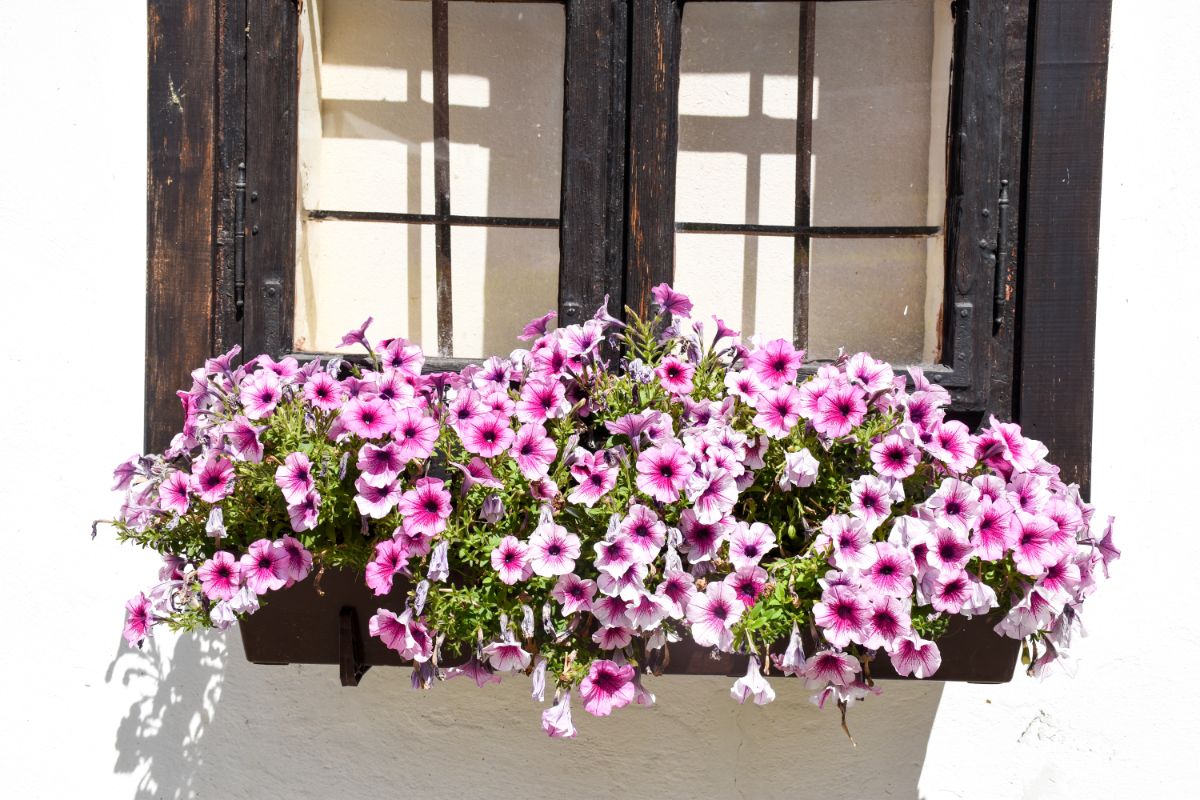
| Plant name: | Petunias |
| Light requirements: | Full sun |
| Water requirements | Moderate |
| Special features: | Long-lasting blooms |
A classic plant for hanging baskets and garden beds, petunias also work beautifully in window boxes, and their sprightly blooms are some of the most intensely colored flowers around. Petunias come in deep shades of pink, purple, yellow, red, and more, and you can even find petunias with two-toned, striped blooms. For an even more fantastic color, try out Wave petunias, which are hardier than other petunias species, and they also bloom more prolifically.
Interestingly, petunias belong to the Nightshade family, which includes edible crops like tomatoes and potatoes. Although petunias aren’t appropriate for eating, they are reliable bloomers, and their trumpet-shaped flowers are always a hit with hummingbirds!
5. Verbena (Verbena spp.)
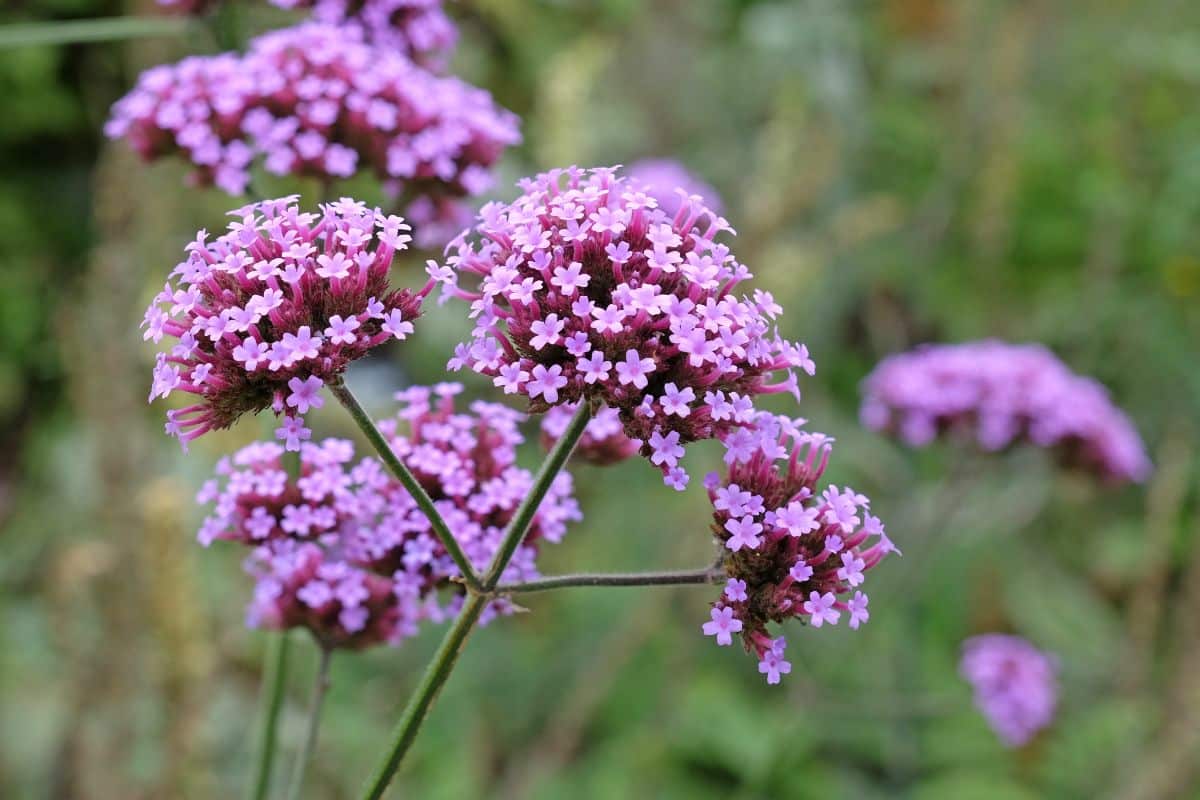
| Plant name: | Verbena |
| Light requirements: | Full sun |
| Water requirements | Moderate |
| Special features: | Pollinator favorite |
There are over 150 different types of verbena plants, and some verbena grows perennially, while others are annuals. Annual verbenas are every bit as pretty as long-lasting perennials, and they have clustered flowers that appear atop long and slender stems, which gives the plant an airy effect. Most of the time, you’ll find verbena flowers in shades of pink, purple, and white, but you can also locate blue, apricot, and bicolored verbena blooms.
Some verbena plants emit a delicate, lemon-like scent, while others are said to produce a “clean” and “refreshing” aroma. More often, however, verbena plants don’t yield much fragrance, but they’re still hugely popular with pollinators. During hot summers, annual verbena plants may stop flowering, and perennial verbena may be better choices for areas where summers produce scorching temperatures.
6. Marigolds (Tagetes spp.)
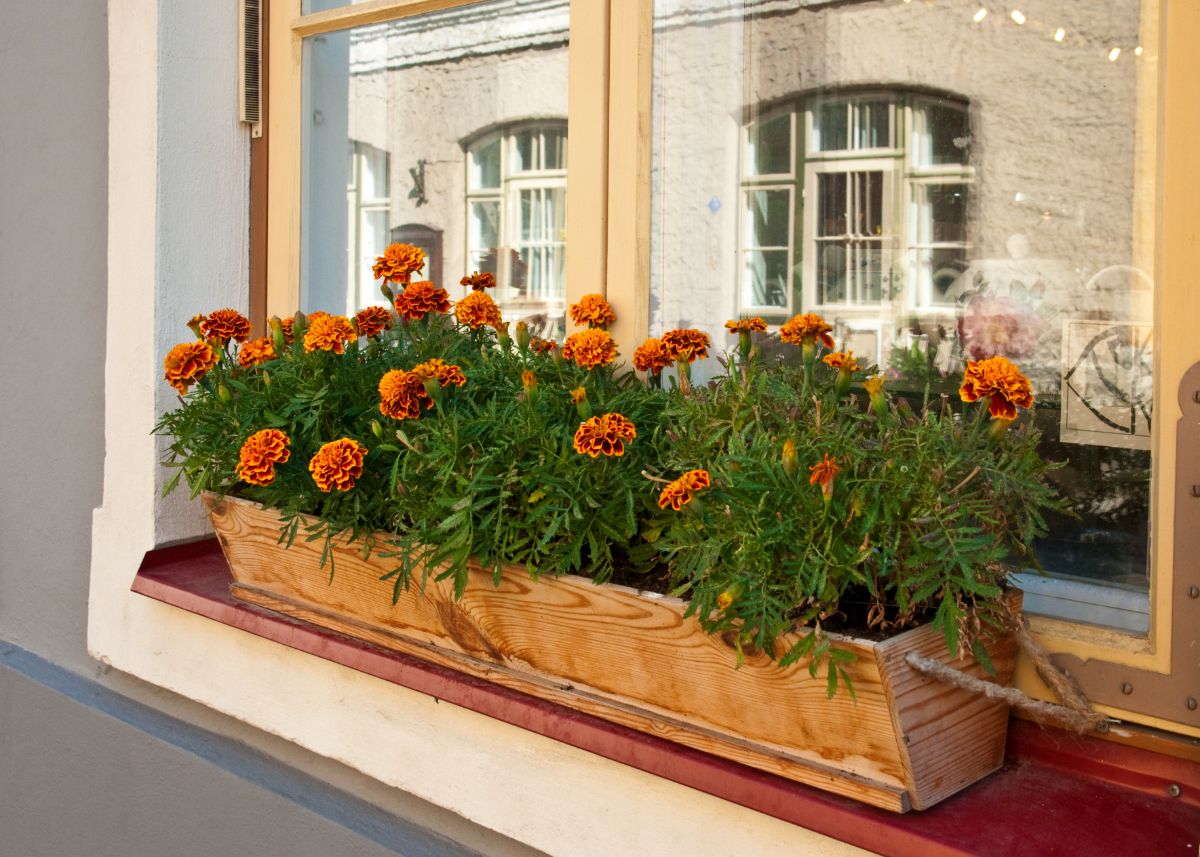
| Plant name: | Marigolds |
| Light requirements: | Full sun |
| Water requirements | Moderate |
| Special features: | Can control pests naturally; Long-lasting blooms |
Marigolds are often associated with the fall because of their autumnal colors and their ties to the Dia de los Muertos holiday. But marigold flowers can be enjoyed throughout the seasons, and you can even keep marigolds blooming in winter if you live in a mild climate!
Marigolds’ button-shaped flowers most commonly come in shades of gold, orange, and red, and some plants produce flowers with bicolored petals. Depending on the size of your window box, you can choose between tall marigolds that stretch up to 3’ high and dwarf marigolds that grow to about 6” tall. And if you need even more reasons to grow marigolds, these plants help to repel garden pests, and they can shield neighboring plants from pests like aphids!
7. Canna lilies (Canna spp.)
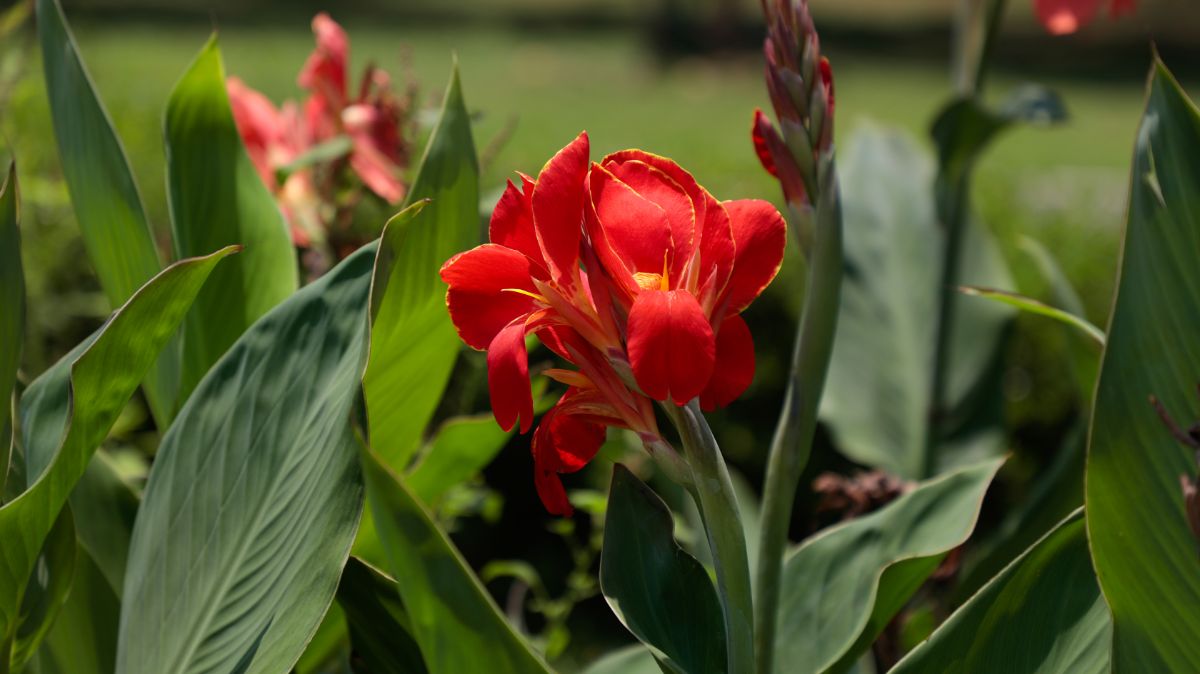
| Plant name: | Canna lilies |
| Light requirements: | Full sun to part shade |
| Water requirements | Moderate |
| Special features: | Tropical look |
If you love tropical-looking plants, canna lilies are must-haves for your window box garden. These plants produce exuberant flowers that bring to mind sunny islands and beachy days, but canna lilies can be grown as annuals in cool locations! Full-sized canna lilies grow approximately 3 to 5’ tall, which can be too big for some window boxes, but you can track down dwarf varieties that max out at around 2’ high.
In warm areas, canna lilies grow as perennials, but these plants are not frost hardy, and they will die away when temperatures drop in fall. But if you don’t want to say ‘goodbye’ to your canna lily plants just yet, you can overwinter your plants indoors. Just dig up canna lily tubers in the fall and overwinter them indoors (like you would dahlias) until temperatures improve.
8. Herbs
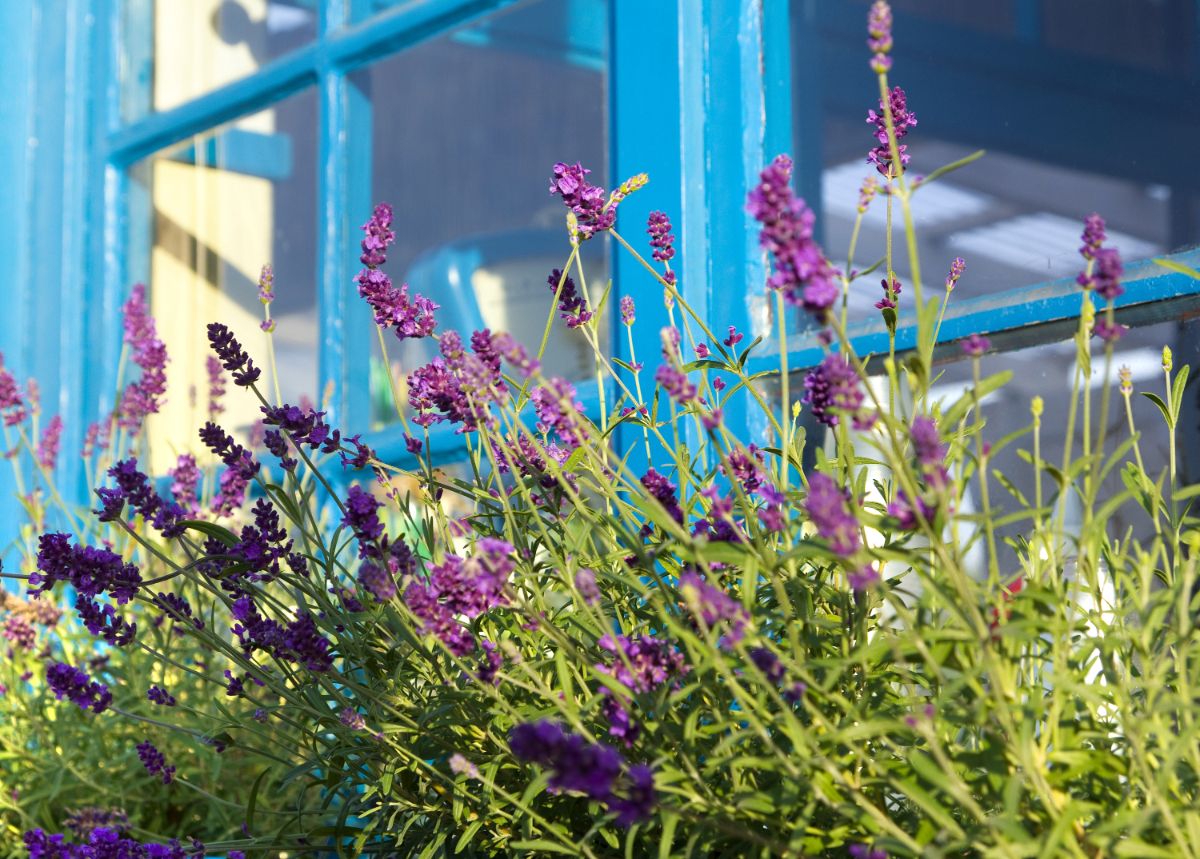
| Plant name: | Herbs |
| Light requirements: | Full sun to part shade, depending on a variety |
| Water requirements | Moderate to low |
| Special features: | Edible; Pollinator favorite |
Zinnias are lovely, and heliotropes are pretty, but if you want to get even more value out of your window boxes, you can use them to grow edible plants, too! Ornamental peppers, ornamental kale, and Swiss chard all grow beautifully in window boxes, and many of these plants can also tolerate frost. But if you’re not quite ready to take the step of growing vegetables, you can also plant culinary herbs in window box planters and harvest your own herbs just as you need them.
Many herbs grow well in window boxes, but plants like sage and mint can get too large for small space planters. Cilantro, parsley, chamomile, and basil are all easy herbs to keep, and they grow as annuals in most areas, while hardier herbs like thyme and oregano can kept perennially in even cool climates. Just make sure you select food-safe growing containers if you want to keep herbs and other edibles, as plants can sometimes absorb yucky contaminants from the pots and soil they’re growing in!
9. Sweet alyssum (Lobularia maritima)

| Plant name: | Sweet alyssum |
| Light requirements: | Full sun to part shade |
| Water requirements | Moderate |
| Special features: | Delicate, honey-like scent |
If you want to make your window box garden a delight for all of your senses (not just your eyes!), look for fragrant annual plants. Today, there are many annuals that can add a rich fragrance to planters and garden beds, but time and time again, sweet alyssum is at the top of fragrant plant lists. Aside from their gorgeous clusters of white and purple flowers, sweet alyssum plants are famed for their sweet, sweet fragrance, which is said to smell a lot like fresh honey!
Some gardeners grow sweet alyssum in inground gardens, and these plants can even be used as flowering ground covers. But if you only have a small space garden or just a few window boxes for flowers, sweet alyssum is just as happy growing in a limited space. Like verbena, sweet alyssum doesn’t handle heat well, and plants will usually stop flowering in summer, but they’ll perk right up and bloom again as soon as fall arrives!
10. Impatiens (Impatiens spp.)

| Plant name: | Impatiens |
| Light requirements: | Shade |
| Water requirements | Moderate |
| Special features: | Good for shade gardens |
Most plants chosen for window boxes are high-sun plants that need 6 to 8 hours of direct light to grow and flower. But if your home is on a shadier lot, your window boxes may not receive enough light throughout the day to satisfy sun-hungry plants. But that’s where impatiens come in!
Impatiens aren’t just lovely to look at… they’re also some of the best plants to grow in shady spots. Impatiens can tolerate both full shade and part shade, but they do need lots of water, so make sure you water your plants regularly. Impatiens blooms come in many colors, including pink, salmon, and white, and they also press well if you’re into crafting with flowers!
11. Zonal geraniums (Pelargonium zonale)
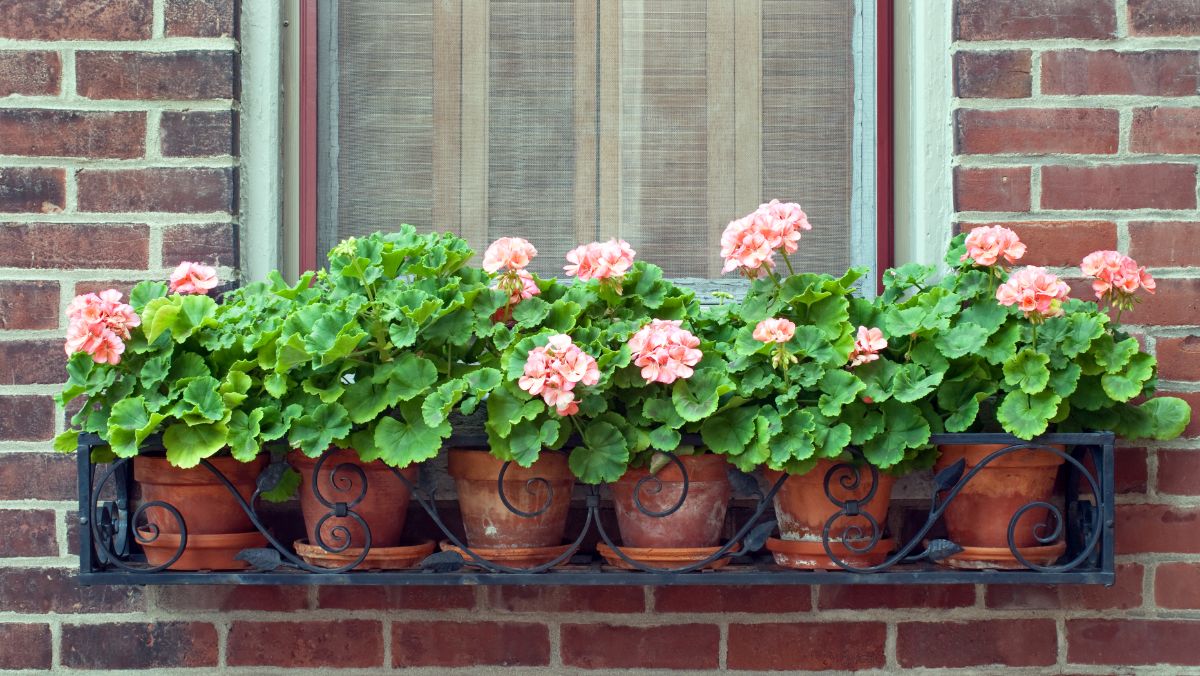
| Plant name: | Zonal geraniums |
| Light requirements: | Full sun |
| Water requirements | Moderate |
| Special features: | Long-lasting blooms |
Whether you keep them in pots or window boxes, geraniums have a timeless beauty that can be used to accentuate any home. Most commonly, you’ll find geraniums with red, white, or pink blooms, but some varieties also sport orange, mauve, or purple flowers. When cared for properly, zonal geraniums can bloom for many months, with flowers lasting from mid-spring to the first frosts of fall.
Although geraniums will generally bloom with little fuss and maintenance if you want to get even more flowers out of your plants, fertilize your geraniums regularly with a diluted liquid fertilizer. And don’t forget to deadhead spent geranium flowers too. When you pinch back geranium flower stems at the base of the plant, it keeps geraniums looking trim, but it also encourages plants to sprout more blooms!
12. Begonias (Begonia spp.)
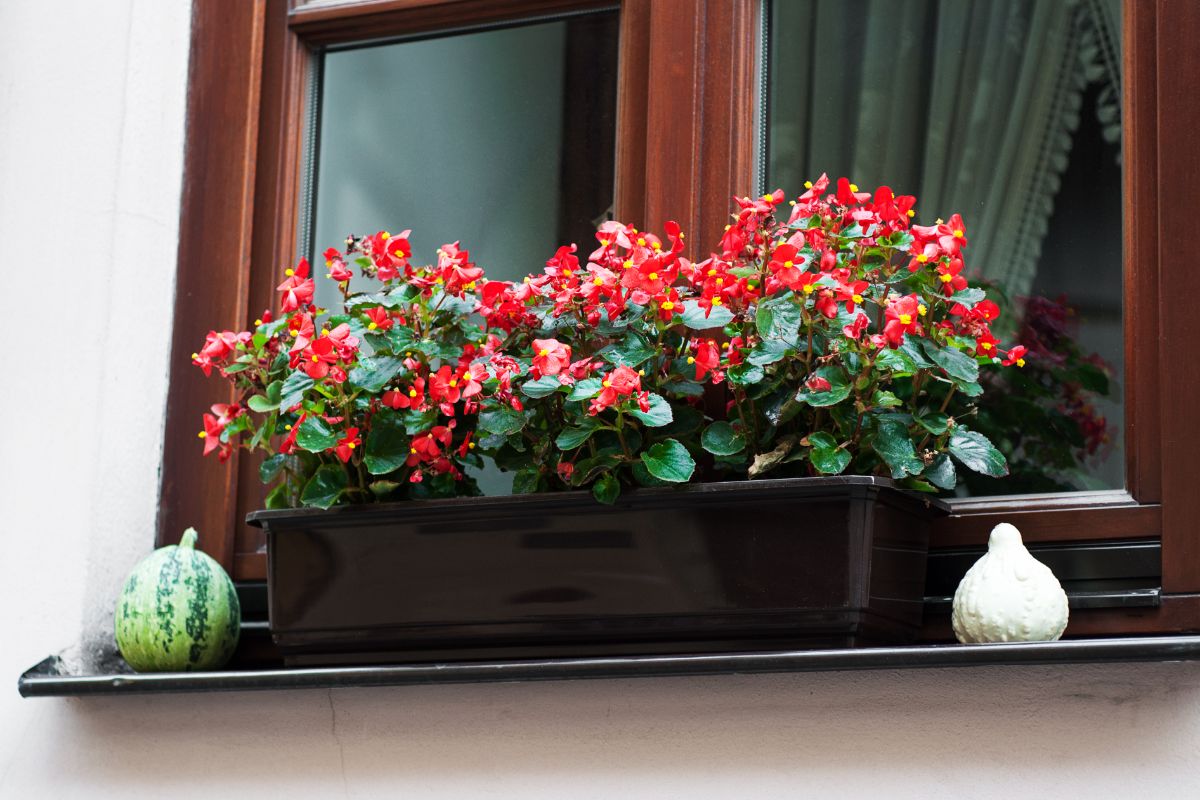
| Plant name: | Begonias |
| Light requirements: | Part shade |
| Water requirements | Moderate |
| Special features: | Can double as houseplants |
There are many types of begonias, and some of them are more suitable for window boxes than others. Cane-type begonias have strikingly colorful leaves, and some cane begonias even produce spotted foliage. However, these begonia types tend to get quite large, and they may overwhelm small window box planters.
If you’re working with a small space, try out more compact begonia types like rex begonias. These plants are every bit as pretty as taller begonias, but they grow to about 12 to 24” high. Plus, these begonia species grow so well in containers that you can bring them indoors and keep them as houseplants during winter if you want to!
13. Cosmos (Cosmos bipinnatus)
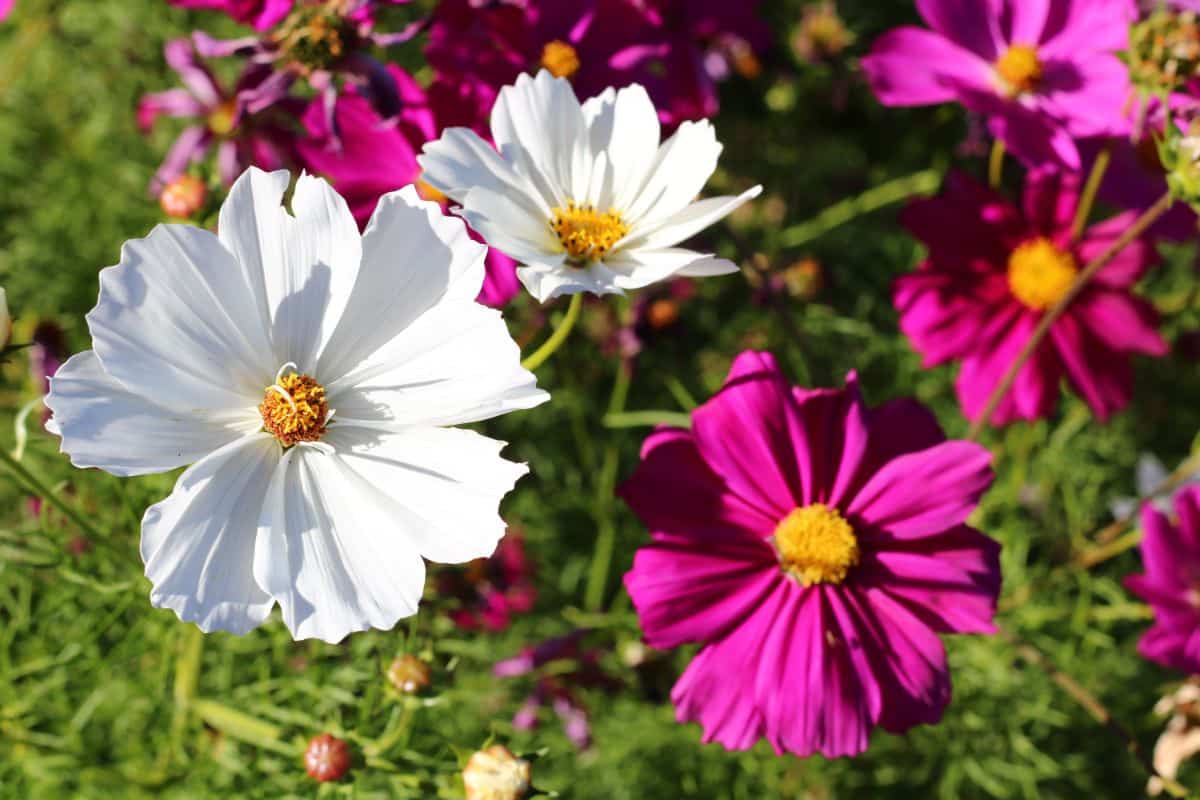
| Plant name: | Cosmos |
| Light requirements: | Full sun |
| Water requirements | Moderate |
| Special features: | Good for cut flowers; Easy to grow from seed |
Like zinnias, cosmos are often used in cut flower arrangements, but they can add grace and beauty to window boxes, too. Cosmos flowers have large and colorful petals that come in shades of pink and white, and flowers appear on the ends of long and airy stems that can add graceful movement to window box arrangements.
Most often, cosmos are grown from seed, but these flowers are fast to sprout, and they often flower in just 50 to 60 days. Most cosmos are true annuals, so they won’t live more than a year even in warm climates, but you can easily collect cosmos seeds in autumn and use the seeds to grow more cosmos next spring!
14. Million bells (Calibrachoa spp.)

| Plant name: | Million bells |
| Light requirements: | Full sun to part shade |
| Water requirements | Moderate |
| Special features: | Long bloom time |
Million bells have trumpet-shaped flowers that look like mini versions of petunias, and they come in a medley of colors, too. Like petunias, million bells have a slightly cascading growth habit, which allows the plant to drape over the edges of window boxes and gives texture to planting designs. Plus, these plants are super easy to grow, and they’ll flower for many months as well.
Million bells can be grown from seed, but most growers purchase these plants as the nursery starts to get flowers earlier in the season. But if you want to get more million bell plants without spending a cent, you can also easily propagate these plants from stem cuttings. Just clip off a healthy length of the stem, remove the lower leaves and any flowers, and place the cutting in soil or water until roots emerge.
15. Heliotrope (Heliotropium arborescens)
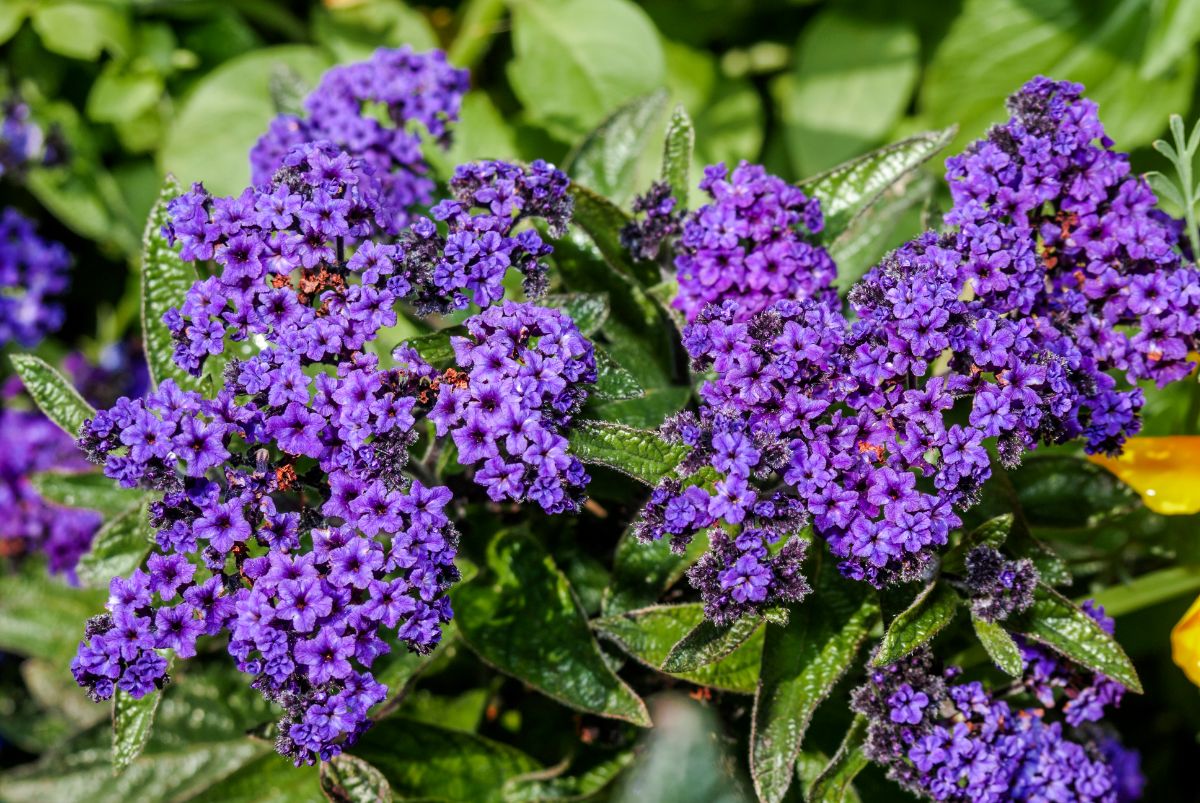
| Plant name: | Heliotrope |
| Light requirements: | Full sun |
| Water requirements | High to moderate |
| Special features: | Fragrant |
Heliotrope is a less commonly grown plant than some of the other choices on this list, but that doesn’t mean it’s any less spectacular. Heliotropes have clusters of richly hued flowers in shades of purple and white, and they coordinate nicely with other window box plants, like verbena and sweet alyssum. However, most growers keep heliotrope for its enthralling scent, which smells a bit like sugary cherries and almonds!
Among heliotrope’s many charms is the plant’s ability to move with the sun. Known as heliotropism, heliotrope flowers shift towards the light, which can make the plants look different as the sun changes directions throughout the day. Sunflowers and some other garden plants also display this characteristic, and heliotropism was even noted in the Greek myth of Clytie!
16. Ranunculus (Ranunculus spp.)
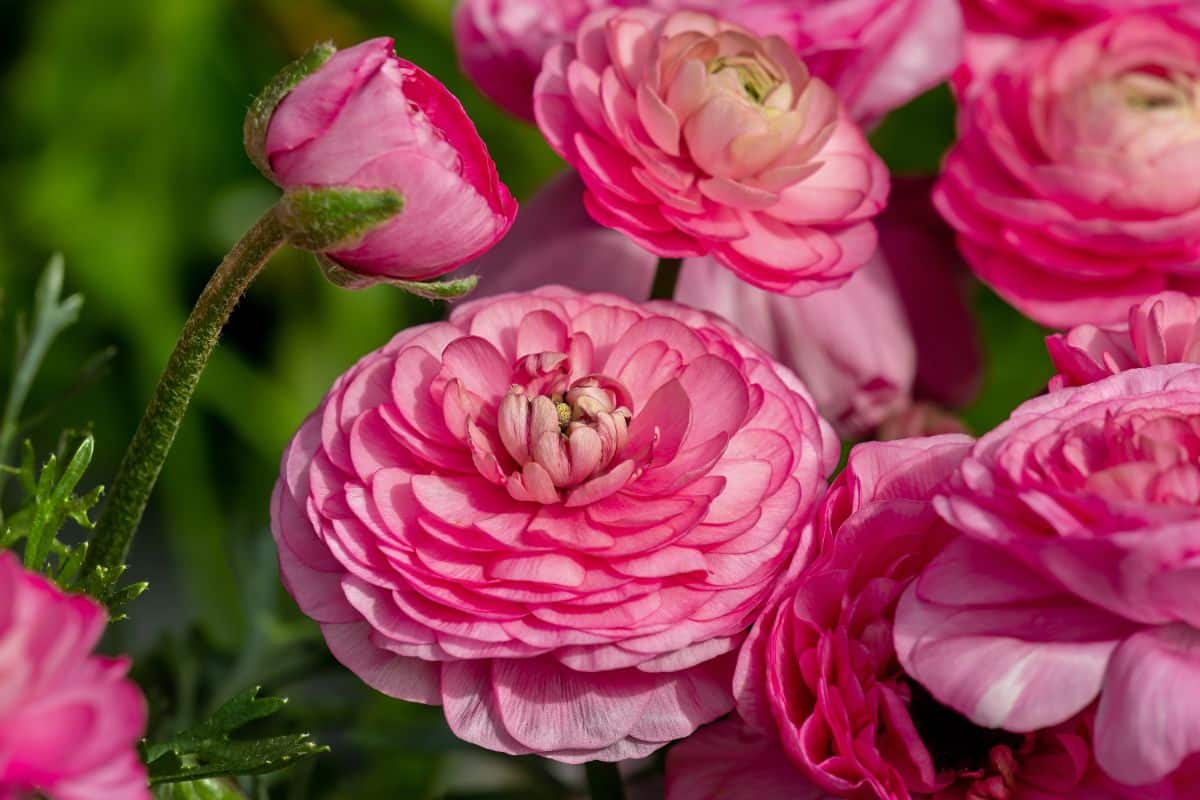
| Plant name: | Ranunculus |
| Light requirements: | Full sun; may benefit from afternoon shade in hot areas |
| Water requirements | Moderate |
| Special features: | Good for cut flowers |
Ranunculus plants are closely related to buttercups, but unlike their wild cousins, ranunculus blooms display an array of colors, including orange, pink, and yellow. A prime candidate for cut flower arrangements, ranunculus flowers make a big impact in window boxes, and they look particularly appealing when paired with other plants with strong shapes, like snapdragons and creeping Jenny.
In warm areas, ranunculus plants grow as perennials, but they can also be cherished as annuals in regions where winters are harsh. In gardens with mild climates, ranunculus bulbs are typically planted in the fall, but it’s best to wait until late winter to early spring to do your planting if you live in growing zones 7 and below.
17. Spider flowers (Cleome spp.)
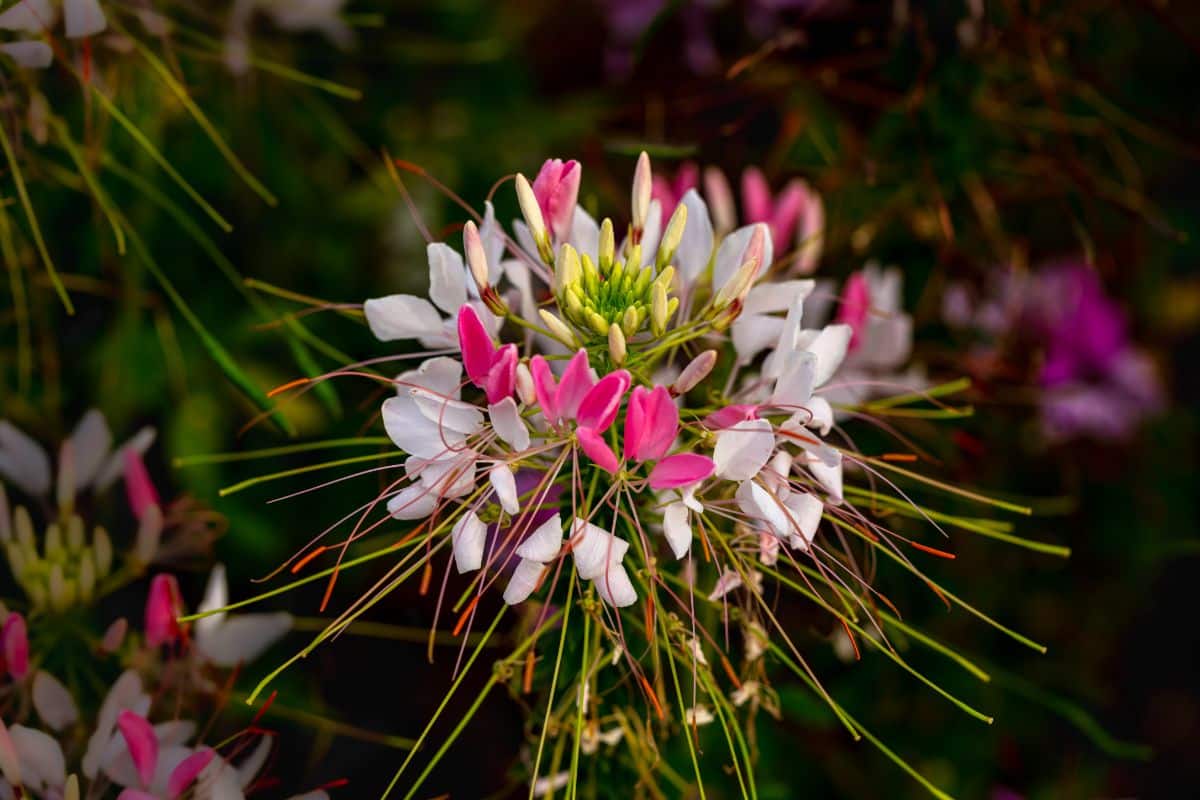
| Plant name: | Spider flowers |
| Light requirements: | Full sun to part shade |
| Water requirements | Moderate |
| Special features: | Pollinator favorite |
Also known as cleome, spider flowers have an interesting and unusual look thanks to their long and slender stamens. These stamens give spider flowers a light and breezy appearance, but they have also inspired the plant’s name, “spider flowers,” since the stamens are said to look like the legs of an arachnid! Cleome blooms last from early summer until fall frosts arrive, and blooms appear in an assortment of shades, including pink, purple, and white.
Spider flowers are often grown in garden beds, and they produce an impressive display of color when they’re clustered in large groupings. However, the spider flowers that are planted in flower gardens are typically tall plants that can grow up to 5’ high. For window boxes, look for smaller cleome cultivars that stay under 2’ tall and try these plants out with plants with contrasting shapes, such as ranunculus and sweet alyssum.
18. Creeping Jenny (Lysimachia nummularia)
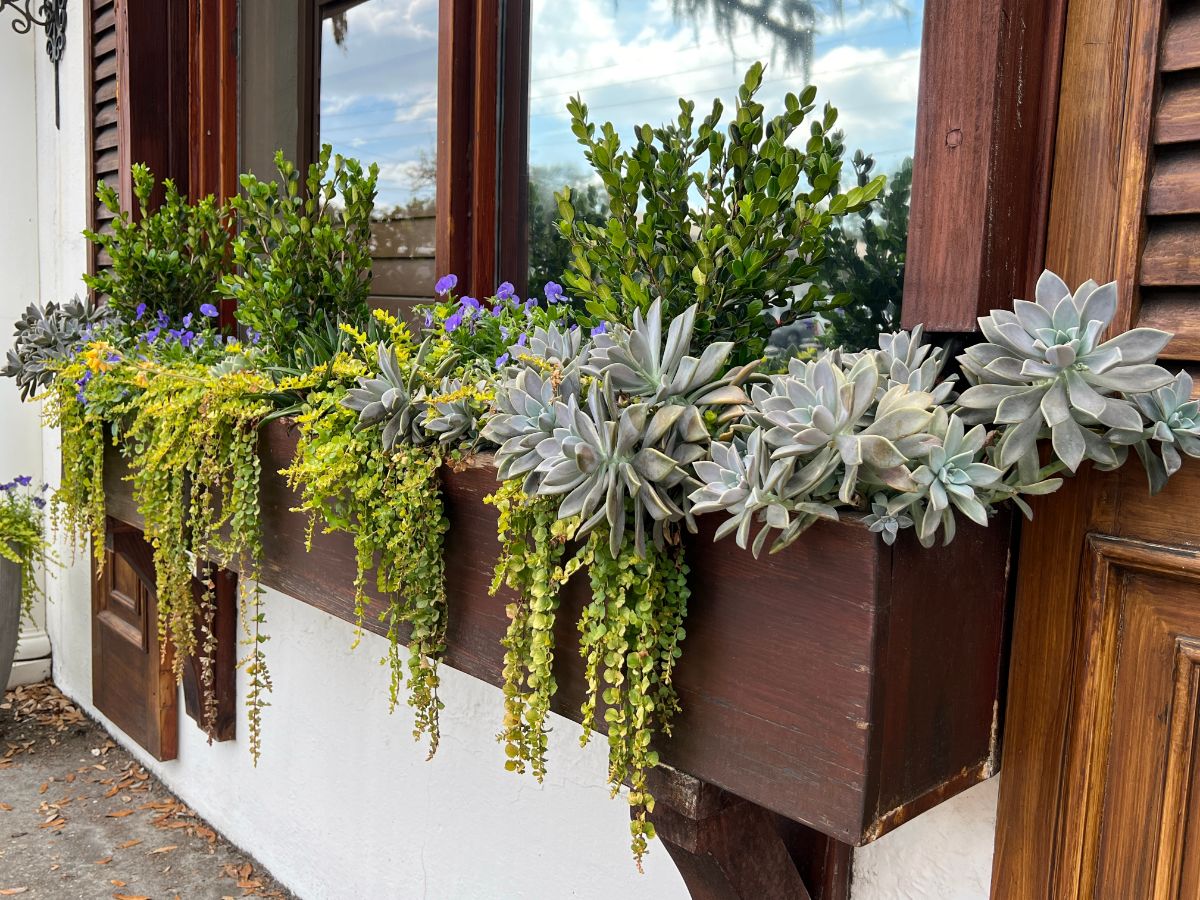
| Plant name: | Creeping Jenny |
| Light requirements: | Full sun to part shade |
| Water requirements | High to moderate |
| Special features: | Trailing stems add movement |
Creeping Jenny is technically a perennial plant even in cool climates, but it’s just so useful in window box displays that it had to make its way onto this list! Most window box plants have an upright growth habit and a relatively short stature. However, if you’d like your window boxes to have a more complex look, you may also want to add some trailing or “spiller” elements to your planter arrangement.
There are many different spiller plants that can be grown in window boxes, including ivies, string of pearls, and inchplants. But creeping Jenny is one of the most popular trailing plants around thanks to its bright green leaves and low maintenance needs. Creeping Jenny does like to be watered often, but it can tolerate lower light conditions, and if plants are happy, creeping Jenny will reward you with bright yellow flowers, too!
19. Mums (Chrysanthemum morifolium)
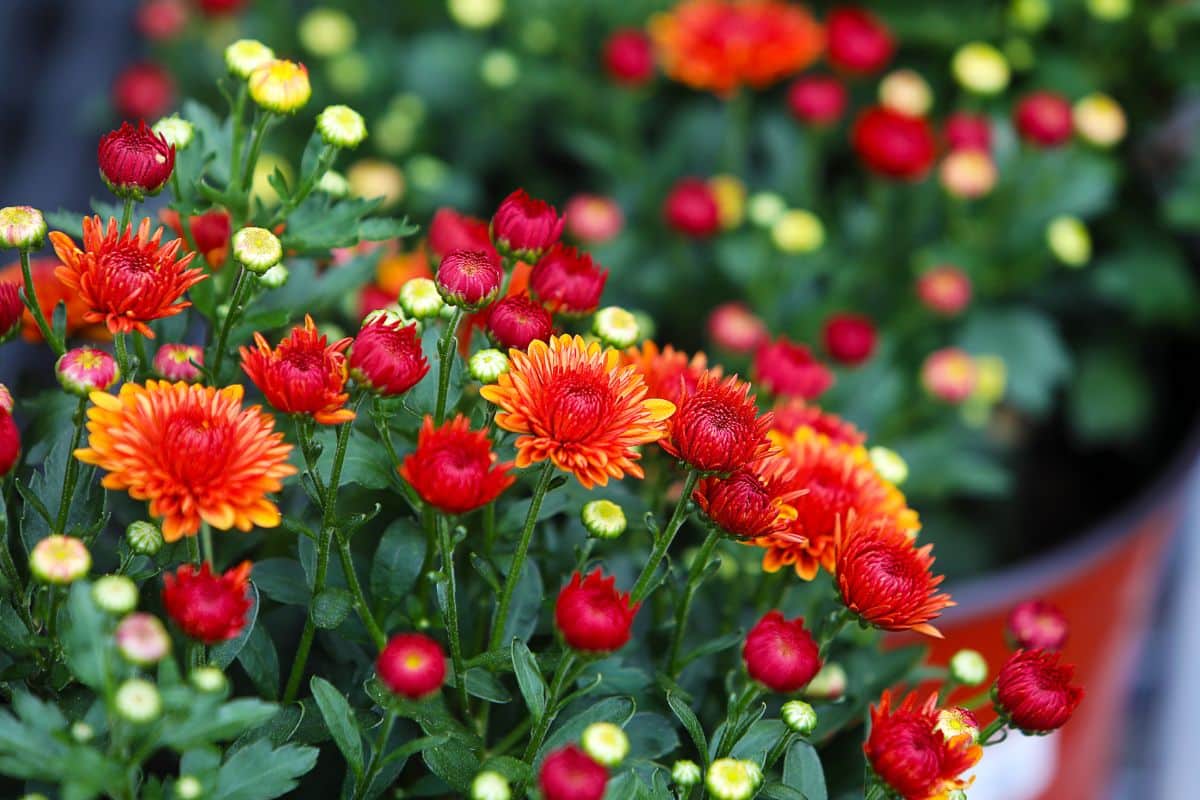
| Plant name: | Mums |
| Light requirements: | Full sun |
| Water requirements | Moderate |
| Special features: | Autumn colors |
Mums can be grown throughout the year, but their autumn colors make them particularly popular options for fall window boxes. These easy-going plants come in many different hues, including purple, orange, and deep wine color, and they’re even somewhat cold tolerant, although mum plants won’t survive a hard frost.
Most people are familiar with upright florist mums, but if you’re keeping a window box, you may also want to experiment with trailing or cascade mums. These showy plants can be used as spiller elements in window boxes, but they will need to be kept in regions with long growing seasons if you want plants to develop that long and trailing effect.
20. Lantana (Lantana camara)
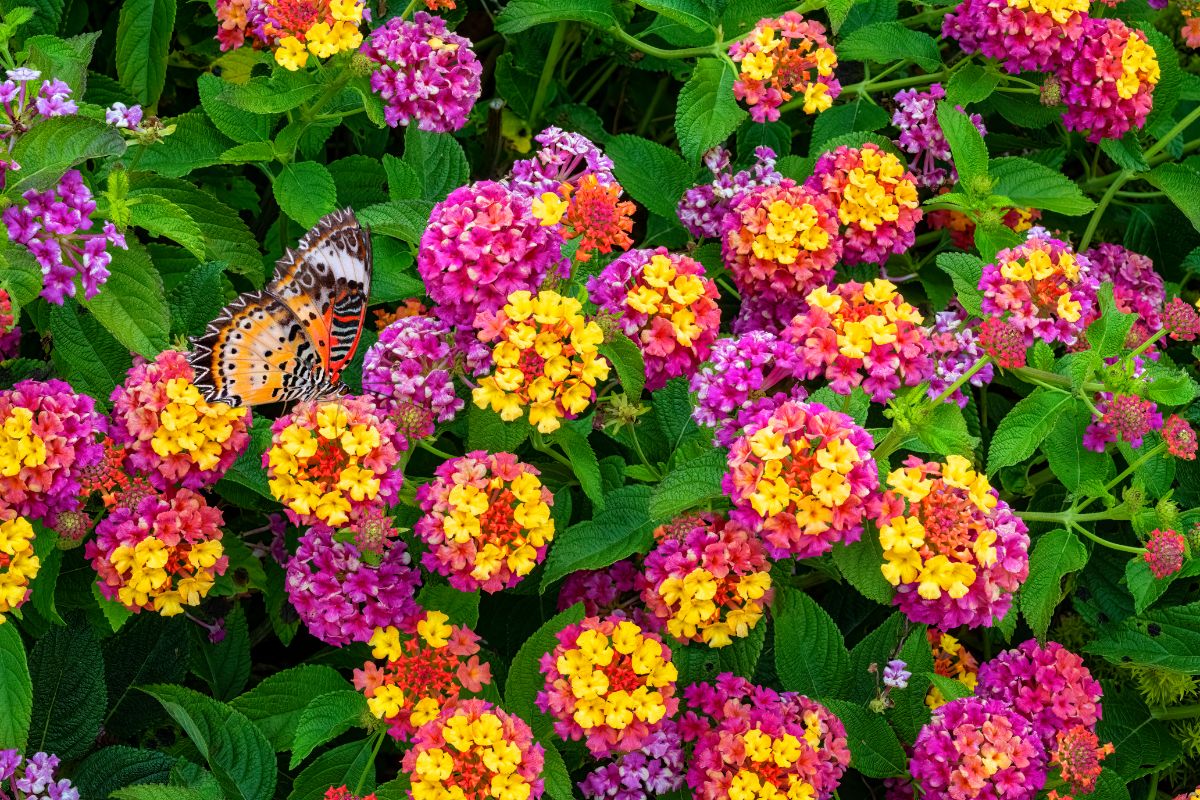
| Plant name: | Lantana |
| Light requirements: | Full sun to part shade |
| Water requirements | Moderate |
| Special features: | Pollinator favorite |
Another pollinator favorite, lantana blooms, are irresistible to hummingbirds, but beneficial insects love these flowers too. If you adore tropical-looking plants but you also want to help out wildlife, lantanas are the plants for you.
In warm areas, lantanas can be grown as perennials, and plants can grow to an impressive height of 6’ or more. In USDA growing zones 7 and below, lantanas are generally kept as annuals, and since they have a shorter growing season, plants stay smaller and usually grow to about 2’ in height.
21. Coleus (Solenostemon scutellarioides)
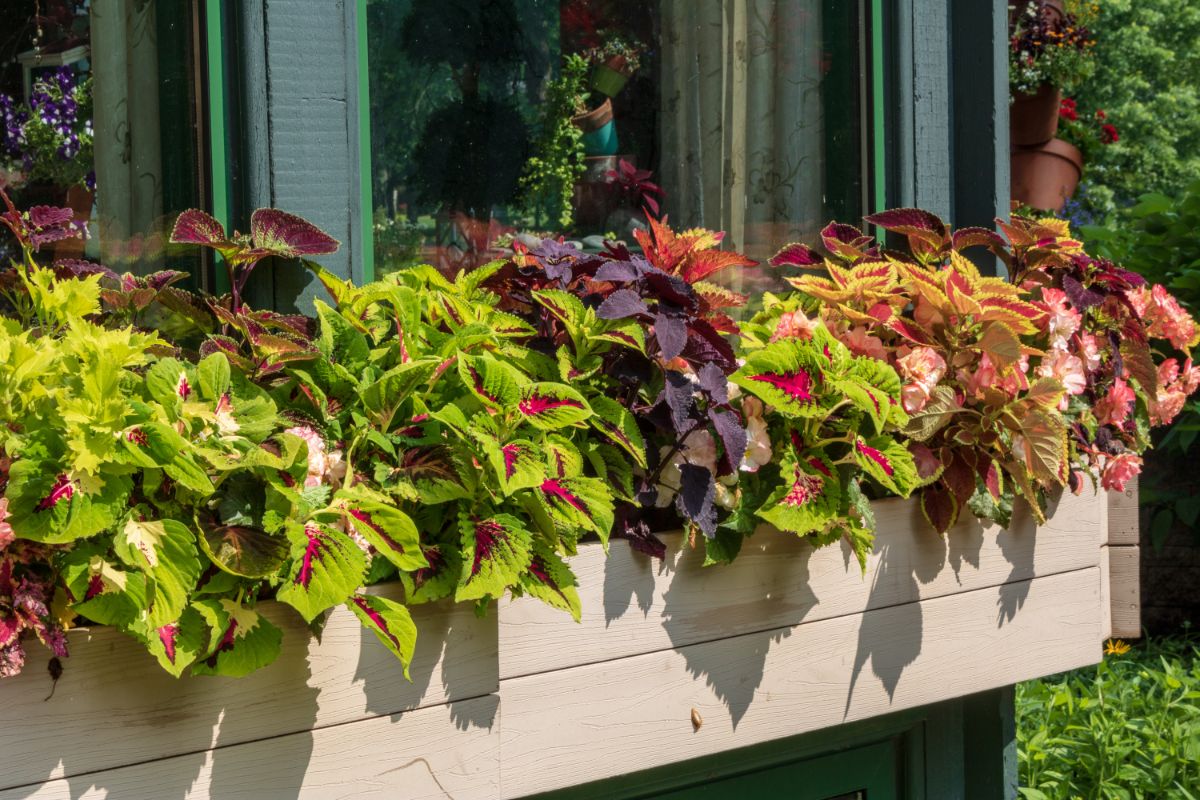
| Plant name: | Coleus |
| Light requirements: | Part shade |
| Water requirements | Moderate |
| Special features: | Can double as houseplants |
Like caladiums, coleus plants rarely flower, but these plants put on an impressive show anyway! Coleus are primarily grown for their colorful leaves that often feature multiple shades of pink, green, white, and other glorious colors. However, if you love plant drama, you can also find coleus plants with deep, dark foliage that looks nearly black in most lighting.
Despite their flamboyant look, coleus are easy-to-grow and ultra-beginner-friendly plants that will keep your window boxes looking colorful throughout the changing seasons. In autumn, coleus plants look stately when paired with mums, but they also bring out the colors of marigolds, petunias, and begonias as well. Best of all, coleus transition easily to indoor life, so if you are fond of these plants, try keeping them as houseplants in winter!
Summary

From alyssum to zonal geraniums, there are many different, colorful annuals to grow in window boxes. These plants are easy to keep, and since they grow as annuals, you don’t need to worry about overwintering them. However, if you love your window box beauties, many of the plants we’ve covered today can also transition to indoor life and be grown as houseplants if that idea appeals to you.
For even more window box garden ideas, check out our guide on cold-tolerant annuals that can survive frosts and freezing temperatures, too!

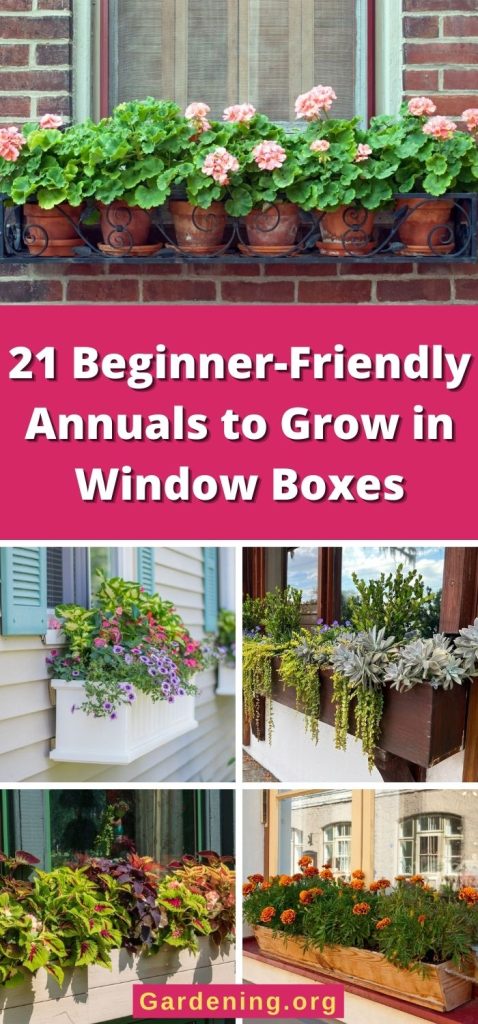


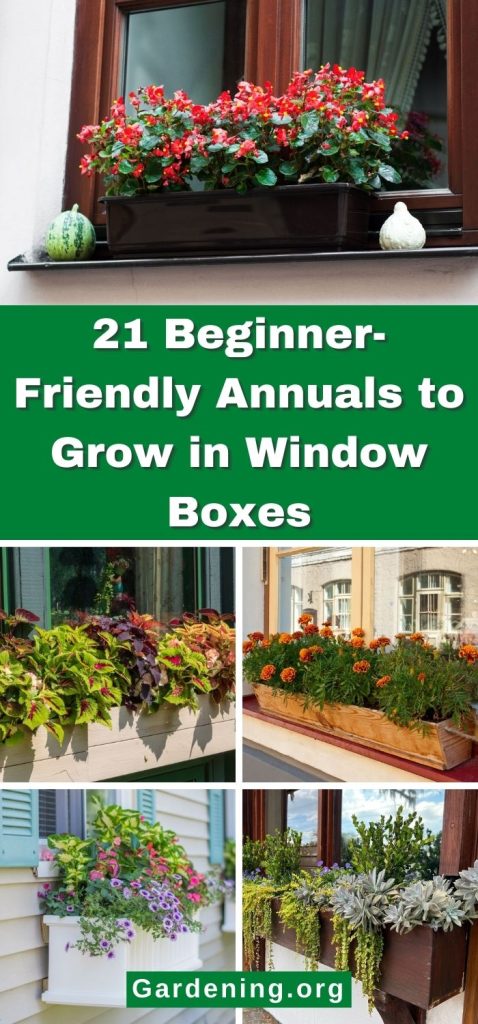




Leave a Reply